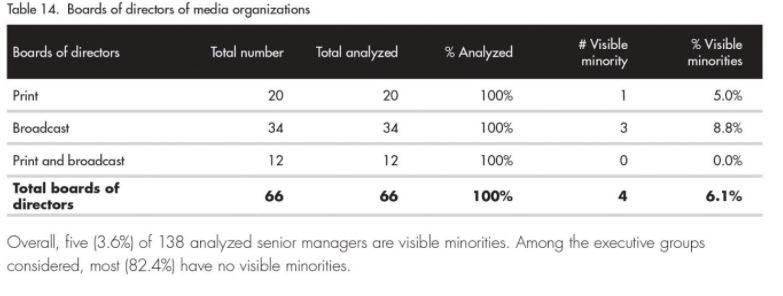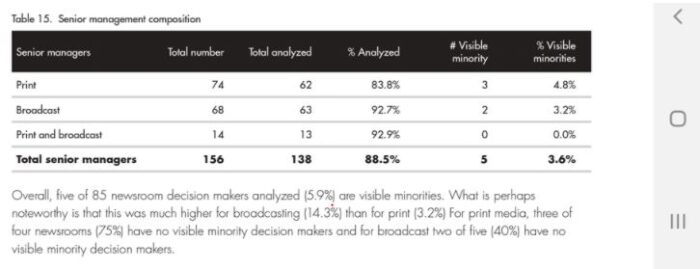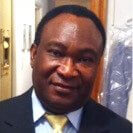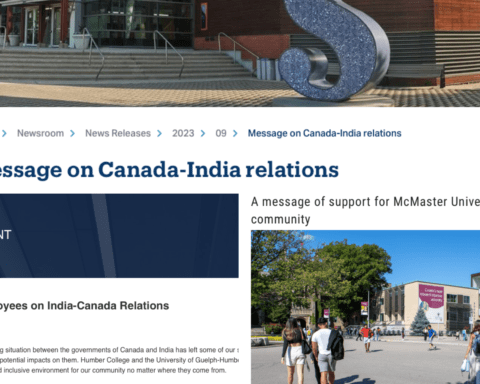Canada’s big media outlets declare they are tackling the underrepresentation of racialized minorities within their ranks and top echelons, but with no consistent statistical data on newsroom diversity, progress will be hard to measure.
The admission comes on the heels of an ongoing survey by the Canadian Association of Journalists (CAJ) to investigate what it calls a “widespread consensus around the need for Canadian media to reflect the society it serves.” The survey, requiring journalists and media outlets across Canada to fill out questionnaires, providing information about their actions in relation to racial and gender compositions of their workforce, will be conducted through the first week of April 2021.
“You can’t look at a city like Toronto boasting 53 per cent of visible minorities and not think that it’s imperative to reflect that population in the newsroom and upper management,” says Canadian Broadcasting Corporation’s director of engagement and inclusion Nick Davis. “You have to know your audience.”
Davis said that an ongoing program, which began four years ago, is helping to boost minority representation across every platform of the CBC network. Called the Developing Emerging Leaders Program (or DEL), the project aims to harness the talents of racialized personnel and targets them for higher-up positions within the CBC.
“About half of all Star editorial hires in the past two years have been talented journalists of colour,” notes director of communications at Torstar, the publisher of Toronto Star, Bob Hepburn. “That’s a small step, and we commit to advancing that growth in the future.” He said Torstar realizes there needs to be more representation of people of all backgrounds “especially as our society’s demographics is continually changing.”
Phyllise Gelfand, vice president of communications for the Postmedia Network, concurs. Speaking on behalf of her organization, she said the Postmedia Network (publisher of several titles including National Post and the Ottawa Citizen), “like many companies, is revisiting our work on diversity and inclusion across the organization including re-reviewing our hiring practices.”
“We embrace diversity because we know it makes us stronger as an organization…and we want to ensure that we are doing our best to hire from diverse backgrounds,” Gelfand added.
Current status: unknown
Asked about their current breakdown of employees along ethnic and gender lines, none of the spokespeople except Davis of CBC provided a meaningful response: “17 per cent of racialized minorities make up the entire CBC organization. The French Service is worse with only 5.3 per cent making up its entire staff, according to our own figures.” He added that though he doesn’t have numbers for each CBC market in the country, he postulates that the Toronto headquarters likely shows figures “slightly higher than the national average”. (The Crown corporation still does not have a Black person on its board of directors.)
Other media organizations said they either do not collect such data or do not disclose it. The Globe and Mail, one of Canada’s biggest national newspapers, failed to respond to repeated email requests for comment.
Torstar’s Hepburn said the publisher “does not collect any formal statistics or breakdown about the racial, ethnic, religious or other diverse makeup of our newsrooms. In fact, the company is not allowed by law to ask employees or prospective candidates to identify themselves as such, although staff can self-identify in voluntary, informal surveys.”
Gelfand replied via email (and maintained the same response after pressing the question several times) that “we do not disclose the makeup of our employees by ethnicity, gender, etc”.
A diverse city?
“It’s not true that there’s any law that prevents them from giving you the information you’re seeking,” says John Miller, emeritus professor of journalism at Toronto’s Ryerson University.
In 2004 Miller did a survey called “Who tells the news?” that was endorsed by the Canadian Association of Newspaper Editors to look into diversity and equity issues in Canada’s big media, and to find out if they reflect the population in which they exist.
But Miller soon fell out of love with the association because “they didn’t like the report I brought back to them. They were uncomfortable with it. They saw me as a prophet of doom, and they cut me loose,” he says.
Over a 10-year period, between 1994 and 2004, the study found “Non-whites constitute 3.4 per cent of the newsgathering staffs of 37 papers that returned questionnaires, compared to 2.6 per cent of staff at papers which responded to a similar survey in 1994.” The gap in representation had grown over this period, he discovered.
In another “DiverseCity” study co-authored with Ryerson’s Dr. Wendy Cukier, Miller looked at media representation in the city of Toronto and in the GTA. In a region where racialized minorities and new immigrants make up more than half of the population, there were only 6.1 per cent minority members on the leading newspaper and broadcast media (see chart below) boards of directors.
“Talk is cheap”
The figures cited by Miller caught the attention of Christina Gonzales, opinions editor at Maclean’s Magazine, who noted in 2019 that “the stats on newsroom diversity are grossly outdated and uncomfortable to examine.”
Another concern raised by Gonzales is the absence of consistent data on the issue of diversity in Canada’s big media outlets. “The fact that there’s been no concerted effort to publish current statistics on diversity trends in media signals an even greater concern—while newsroom diversity is abysmal, we’re idle, and simply too embarrassed to address it,” she said.
In that regard, the responses from some of the nation’s big media organizations about their equity status are a case in point.
Ratna Omidvar, federal independent Senator from Ontario, says “it’s a lame excuse that these media organizations cannot even speak to diversity issues head-on.”
With a long history of speaking to diversity issues, Omidvar said she’s not surprised that Canada’s big media have been bedevilled by inclusion problems for a very long time. “Talk is cheap,” she said, adding, “the media has to be more explicit than simply aspirational.”

Editor’s note: This story has been revised to correct details relating to Miller’s “DiverseCity” study. Sorry

Peter Uduehi is a journalist and currently publisher and editor of African World News in Toronto. Versed in African and American politics, he has spent most of his adult years in the USA where he studied journalism and later worked as reporter and news editor for several US media outlets before emigrating to Canada 10 years ago.





